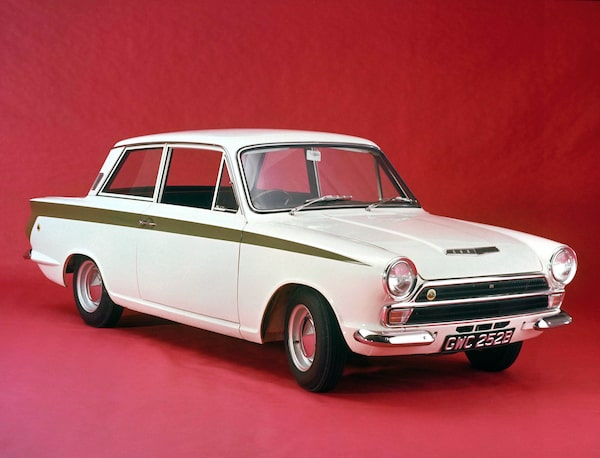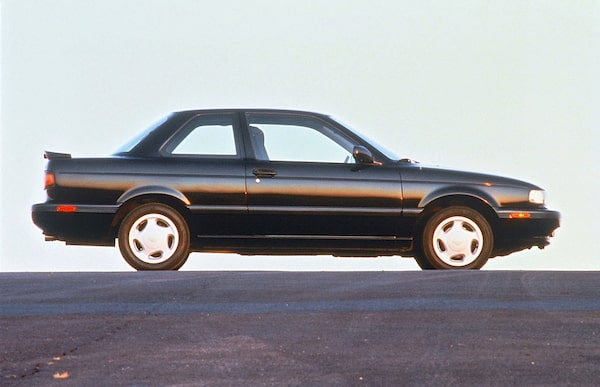There have always been fast sedans, but defining what makes a “sports sedan” could keep gearheads arguing until the oil runs dry. For starters, the BMW 2002 – often called the seminal sports sedan – had only two doors. Shouldn’t sedans have four? And can anything truly be a sports sedan without an available manual gearbox?
Well, it’s my list, so I’m going to stick it to the automatics. Also turfed are any sedans that wouldn’t feel at home on the track. (Let’s save hot hatchbacks for another story.) What we’re left with are seven decades’ worth of sedans, ranked in order of their original debuts, that we think helped define and refine the genre. These were the sedans you could drive to the track with the family on board and take them all home again after you’d done your racing around.
There are many more than we had space for here. No doubt readers will let us know what else should have been included.
1953 Alfa Romeo Giulietta

Courtesy of manufacturer
In the 1950s, a 1.3-litre sedan that could do almost 100 mph (160 km/h) was sensational. With its double-overhead camshaft engine and coil-spring rear suspension, the Giulietta was exceptionally advanced. Besides its “brilliant” performance, reviewers also lauded its brakes, steering and stability. Quoth Motor magazine: “The driver becomes part of the car which he handles with such added skill and confidence that he rises a class, or perhaps two, above his normal form.”
1959 Jaguar Mk2

Courtesy of manufacturer
There’s good reason Jaguar’s compact was equally popular with the robbers driving getaway cars and the cops chasing them. For its era, the Mk2 was a humdinger – four-wheel disc brakes, manual transmission (with an electric-overdrive fifth gear), and twin-cam six-cylinder engine ranging up to 3.8 litres and 200-plus horsepower. No surprise, the Mk2 was also a force in production-sedan racing in its day.
1961 Mini Cooper/Cooper S

Courtesy of manufacturer
The Mini was only meant to be an affordable people’s car, but its revolutionary engineering gave it incredibly entertaining and “chuckable” handling. Enthusiasts quickly saw the potential, and race-car designer John Cooper developed the 1.0-litre Cooper and 1.3-litre Cooper S versions. The tiny terror’s competition record speaks for itself: three wins in the Monte Carlo Rally, five British Saloon Car championships and two European Touring Car titles.
1963 BMW 1800/2000TI

Courtesy of manufacturer
Everybody “knows” the 2002 was the first the sports sedan. But setting aside the fact that the 2002 was a two-door, we think the earlier 1800 four-door earns that honour. Originally launched as a 1500, it graduated though 1.8-litre and ultimately two-litre versions that Road & Track called “the best-performing 2-Liter sedans in today’s market, and the best handling and best riding as well.”
1965 Ford Lotus Cortina

Courtesy of manufacturer
While some cars were born sport sedans, others got there through upward mobility. Ford U.K.’s mass-market Cortina had a tough-as-nails 1.5-litre engine that Lotus used as the basis of the fabled 1,588-cubic-centimetre twin-cam engine in the Elan sports car. When Cortina and twin-cam came together, along with aluminum bodywork and re-engineered suspension, Ford had an effective race car, and gearheads had access to the 1960s equivalent of a Honda Civic Type R.
1972 Datsun 510

Nissan/Courtesy of manufacturer
The Datsun 510 wasn’t intended to be a sport sedan. But as Car and Driver noted in 1968, “Overhead-cam engine, independent rear suspension – on an economy sedan? Seldom do we find such graphic proof that a car was made better than it had to be.” Enthusiasts were quick to realize the 510′s potential, and it soon became a staple of grassroots motor sports, as well as a serial winner in the Sports Car Club of America’s Trans Am racing series.
1982 Rover SD1 Vitesse
Clive DJV White
Yes, this sleek “four-door Ferrari Daytona” was a Rover. With a 3.5-litre V8 engine, it was 1977 European Car of the Year and soon became the police-pursuit car of choice in the U.K. It always was a driver’s car, but especially in later fuel-injected Vitesse models, which beat a BMW 528i in a Motor magazine comparison, won multiple European Touring Car Championship races and clinched the German touring car championship in 1986. Eat that, BMW!
1983 Mercedes-Benz 190E 2.3-16

Courtesy of manufacturer
For years, Mercedes had no answer to the BMW 3 Series, but then came the 1986 190E. Initially it was more baby S-Class than sport sedan, but that changed with the 185-horsepower 2.3-16 (which, incidentally, predated the BMW M3) and its Cosworth-designed 16V cylinder head. Mercedes marked its 1983 debut with a 50,000-km endurance record averaging 248 km/h. The ultimate 232-horsepower winged-wonder Evo II 2.5-16 won the 1992 German Touring Car Championship.
1993 Mitsubishi Lancer Evo

JASON CHATTERLEY DESIGN/Courtesy of manufacturer
There have been many evolutions of Mitsubishi’s World Rally Championship weapon, though only the 2008-2015 generation came to North America. Starting with a humble compact, Mitsubishi created a gearhead hero car with a 2.0-litre turbocharged engine producing around 300 hp, an incredibly intelligent all-wheel-drive system, scalpel-like steering and a responsive, balanced chassis. Truly a precision instrument for skilled driving.
1994 Acura Integra GS-R

Honda/Courtesy of manufacturer
Most Integras were coupes, but the legendary 1.8-litre VTEC engine with its 8,100 rpm red line was also offered in the rarer four-door. Also featuring four-wheel double-wishbone suspension, the Integra GS-R was a legitimate sports sedan that Car and Driver said “made us want to slip in, buckle it on, turn the key to its mesmerizing powertrain, and press its chassis to the task just for the joy of it.”
1994 Nissan Sentra SE-R

Nissan/Courtesy of manufacturer
Nissan lit a spark among gearheads when it paired the two-door Sentra econobox body with the SR20DE engine from the Infiniti G20 and fettled the four-wheel independent suspension to match. In 1991, its first year, the SE-R earned a spot on Car and Driver’s 10 Best list, where it remained for its entire production run. The magazine called it “something we’d wanted for years – BMW 2002 punch at a Datsun price.”
1997 Audi S4 2.7T

Courtesy of manufacturer
The compact A4, which replaced the 90 in 1994, was arguably Audi’s first credible riposte to the BMW 3 Series – and by extension, the S4 was Audi’s equivalent of the M3. Powered by a turbocharged 2.7-litre V6 channelling 250 hp to all four wheels through a six-speed manual, the S4 was the first car to topple the perennial-favourite M3 from its sports-sedan throne in a Car and Driver comparison test.
1998 Ford Contour SVT

Courtesy of manufacturer
Even regular Contours were good enough to make Automobile magazine’s All-Star and Car and Driver’s 10 Best lists. The SVT’s 2.5-litre V6 added 25 more horsepower and a chassis tune that combined exquisite balance and precision with a supple ride. “The steering points the car into curve with just-so precision,” wrote World of Wheels. “This is as close as you’ll get to four-wheel drifts in a front-wheel drive car.”
2004 Cadillac CTS-V

Jim Fets/Courtesy of manufacturer
The 2004 CTS-V was powered by a creamy-smooth 400-horsepower 5.7-litre (later 6.0-litre) Corvette V8. The manual gearbox was a bit of a clunker, but the handling was terrific, and, of course, it was wickedly fast. The 2009 redesign brought a much slicker manual gearbox and added an automatic option while the V8 grew to 6.2 litres and was supercharged up to 556 horsepower. A Cadillac sports sedan? Absolutely.
1978 Saab 99 Turbo

Courtesy of manufacturer
Saab didn’t turbocharge a production car first, but unlike GM’s early-’60s pioneers, the Saab 99 Turbo kicked off a trend that lasted. Motor lauded its “stunning performance” and called it “one of our favourite sporting saloons and … bound to become a ‘collector’s car’ even while still in production.” Saab is gone, but small turbocharged engines in place of naturally aspirated larger ones is now standard industry practice.
1993 Subaru WRX/STI

Krause, Johansen/Courtesy of manufacturer
Like the Mitsubishi Evo, the WRX powered its maker to multiple World Rally Championships (six, between 1993 and 2008). Based on the Impreza compact, the WRX made its debut in 1993 in Japan with 240 turbocharged horsepower and, of course, all-wheel drive. Hatchback and harder-core STI versions soon followed. The WRX didn’t come to Canada until 2002; since then, countless variants and special editions have evolved to the current fourth-generation, 2.0-litre/268-horsepower WRX and 2.5-litre/310-horsepower STI.
Shopping for a new car? Check out the Globe Drive Build and Price Tool to see the latest discounts, rebates and rates on new cars, trucks and SUVs. Click here to get your price.